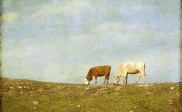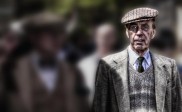How to Make Panoramic Photography
Panoramic Photography
Sometimes a photograph can’t capture everything we want from an image as the frame of the camera we use has its limitations. To overcome this, photographers adopted different techniques to create an image with a larger field of view. By doing this, a new type of photography appeared, in the form of panoramic photography. It is sometimes referred to as wide format photography and it usually consists of a single image that is very wide. In most cases, the image is at least twice as wide as its height. This gives the image a panoramic feel, although the aspect ratio isn’t the only thing that defines the image as being panoramic, an important factor is also the coverage field.
Panoramic photography is commonly used to capture beautiful landscapes that can’t fit into a normal frame but it is also used for other purposes such as capturing a large group of people. Although some photographers use wide angle lenses or fisheye lenses to capture a wide field, they have their limitations. Fisheye lenses, although great because of their interesting effect and the wide angle, they distort the image so they are not a good choice for a wide panoramic image.
How does panoramic photography work?
In order to have a wider coverage field, photographers usually take several photos to capture the desired field of view. To do this, they have to move the camera one frame at a time to the left or right from their fixed position. You can even achieve a full 360 degrees frame by spinning around your fixed position and photographing the environment from a single point. Later, the photographs can be stitched together with the help of a software program. Mounting the images side by side will create a large panoramic view of the photographed area.
Taking the photographs with the purpose of mounting them together is a delicate process as the alignment is very important. It can be difficult to take the photos so that they align perfectly but now there are several cameras that make this job easier. Some digital cameras can do the process of stitching the images automatically and they can also control the exposure so that every frame blends perfectly.
Types of panoramic photography.
There are several types of panoramic sequences that you can take to make a panorama. Basically, they are:
-Horizontal panorama, the sequence can be either taken to the left or right and it’s usually used to capture panoramic views of landscapes.
– Vertical panorama, a sequence taken up or down from the fixed point of the photographer. It usually is used when the subject of the photograph is a tall object, like a building or a tower.
– Clockwise or counter-clockwise panorama, where the sequence is used for any square type shapes.
How to shoot the pictures for a panorama.
Shooting pictures in sequence can be difficult if you try to align the frames perfectly. In most cases you won’t be able to do that anyway; for the best results you should take the shots bearing in mind that each photo should overlap the next one by 30% to 50%. By doing this you’re ensuring that you’ll have a smooth transition between the photos and that the differences between the different exposures won’t cause a problem when blending them together. Also, this will be helpful if something gets into your frame by mistake, like a moving object and you’ll want to edit it. Overlapping the images with up to 50% means that you’ll have to take a lot of shots for your final picture but this will ensure you will have a great panoramic photo at the end. Also try not to go out the vertical alignment by more than 10%.
One of the biggest problems with shooting in sequence, especially if you’re shooting a 360 degrees photo is keeping the camera at the same level. The best way to achieve this is by using a tripod. If you can’t use a tripod, make sure that when you’re shooting from the hand, you’re not moving your body. Try to keep the camera as close to you as possible and rotate as you take the shots from a fixed spot.
When shooting a panorama you’ll most likely shoot a landscape, so in order to have a clear image where the scenery is in focus you’ll have to set a large depth of field. This can be done by closing the aperture a little bit but make sure that you experiment with different settings before you start shooting in sequence. You can also try holding your camera vertically while shooting horizontally in order to capture more of the image’s top and bottom. This can be extremely helpful if you didn’t make the right alignment and you must crop the top and bottom a little, so you won’t lose that much from the image.
Try and set the exposure right. If you’re shooting in sequence and a large part of your scenery is set in shadows or in bright light, you’ll have some big differences between the shots if you keep the exposure the same. Although this can be solved in some part later with the editing software, it’s best to have a similar exposure for each frame as it will allow the images to blend more smoothly.
How to make the panorama from your shots.
Once you’ve succeeded in taking the shots you require to make your panorama, it’s time to stitch them together to compose a single image. This can be done with most of the image editing software that is available but in order to achieve the best results you should prepare your images accordingly. Ideally you should take time to calibrate your photos by taking into account each of the shot’s different settings, and to minimize the differences that appear mostly because of different exposures. The images can have other differences as well and taking them into account and editing them before applying the stitching process is very important.
Blending the images together for that perfect panorama requires you to do the adjustments of the light, color and contrast according to how you’ve found them in the calibrating process.
According to the software you’ll use, you could have different options to stitch the images together and you should try and experiment with them:
– Mosaic, a method of stitching images taken with the camera being perpendicular to the subject, and not rotating.
– Single shot panorama, if the image was taken with a parabolic mirror instead of normal lenses.
– Pano camera panorama, stitching the images taken with a specialized panoramic camera.
– Single row panorama, stitching a line of images created by a rotating camera.
– Multi row panorama, stitching more lines, or rows of images created by a rotating camera.
– Spherical panorama, where pictures are stitched in a spherical way.
Equipment for panoramic photography.
Depending on your scenery and the type of panoramic photography you want to create, you should take into account the different gear you can use to achieve the best results:
– Get a good tripod that is stable and has a fine level as you don’t want the level of your camera to move up or down while you rotate it.
– If your tripod doesn’t have a leveler, get a separate one to level the camera.
– A panoramic head, it’s essential for 360 degrees panoramas; it mounts the camera to the tripod and enables it to rotate easily.
– Wide lenses. Get some if you’re shooting landscapes as they will make the job a lot easier and will provide you with more field coverage.
As panoramic photography takes some time and practice to get it right, you should take a look at works from other photographers and be inspired.
Below are some great examples of panoramic photography:

Photo By Bozack

Photo By Nzeman

Photo By AndreasResch

Photo By IAMSORRY87

Photo By Reduasch

Photo By SeptSky

Photo By HDRenesys

Photo By dominiquedidier

Photo By dominiquedidier





You can also try this application: http://bstdownload.com/reviews/acropano-photo-stitcher-2/
I was wondering if there is a way to make the panorama picture not so long in comparison to the other pictures. Can it be adjusted without messing up the relationships.
Does the more shots you take to be stitched affect the skinniness of the final product.